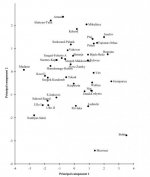Slavs
At present the customary name for all the Slavonic races is Slav. This name did not appear in history until a late period, but it has superseded all others. The general opinion is that it appeared for the first time in written documents in the sixth century of the Christian era. However, before this the Alexandrian scholar Ptolemy (about A.D. 100-178) mentioned in his work, "Geographike hyphegesis", a tribe called Stavani (Stavanoi) which was said to live in European Sarmatia between the Lithuanian tribes of the Galindae and the Sudeni and the Sarmatic tribe of the Alans. He also mentioned another tribe, Soubenoi, which he assigned to Asiatic Sarmatia on the other side of the Alani. According to Safarik these two statements refer to the same Slavonic people. Ptolemy got his information from two sources; the orthography of the copies he had was poor and consequently he believed there were two tribes to which it was necessary to assign separate localities. In reality the second name refers very probably to the ancestors of the present Slavs, as does the first name also though with less certainty. The Slavonic combination of consonants sl was changed in Greek orthography into stl, sthl, or skl. This theory was accepted by many scholars before Safarik, as Lomonosov, Schlözer, Tatistcheff, J. Thunmann, who in 1774 published a dissertation on the subject. It was first advanced probably in 1679 by Hartknoch who was supported in modern times by many scholars. Apart from the mention by Ptolemy, the expression Slavs is not found until the sixth century. The opinion once held by some German and many Slavonic scholars that the names Suevi and Slav were the same and that these two peoples were identical, although the Suevi were a branch of the Germans and the ancestors of the present Swabians, must be absolutely rejected. Scattered names found in old inscriptions and old charters that are similar in sound to the word Slav must also be excluded in this investigation.
After the reference by Ptolemy the Slavs are first spoken of by Pseudo-Caesarios of Nazianzum, whose work appeared at the beginning of the sixth century; in the middle of the sixth century Jordanes and Procopius gave fuller accounts of them. Even in the earliest sources the name appears in two forms. The old Slavonic authorities give: Slovene (plural from the singular Slovenin), the country is called Slovensko, the language slovenesk jazyk, the people slovensk narod. The Greeks wrote Soubenoi, but the writers of the sixth century used the terms: Sklabenoi, Sklauenoi, Sklabinoi, Sklauinoi. The Romans used the terms: Sclaueni, Sclauini, Sclauenia, Sclauinia. Later authors employ the expressions Sthlabenoi, Sthlabinoi, while the Romans wrote: Sthlaueni, Sthlauini. In the "Life of St. Clement" the expression Sthlabenoi occurs; later writers use such terms as Esklabinoi, Asklabinoi, Sklabinioi, Sklauenioi. The adjectives are sclaviniscus, sclavaniscus, sclavinicus, sclauanicus. At the same time shorter forms are also to be found, as: sklaboi, sthlaboi, sclavi, schlavi, sclavania, later also slavi. In addition appear as scattered forms: Sclauani, Sclauones (Sklabonoi, Esthlabesianoi, Ethlabogeneis). The Armenian Moises of Choren was acquainted with the term Sklavajin: the chronicler Michael the Syrian used the expression Sglau or Sglou; the Arabians adopted the expression Sclav, but because it could not be brought into harmony with their phonetical laws they changed it into Saklab, Sakalib, and later also to Slavije, Slavijun. The anonymous Persian geography of the tenth century used the term Seljabe.
Various explanations of the name have been suggested, the theory depending upon whether the longer or shorter form has been taken as the basis and upon acceptance of the vowel o or a as the original root vowel. From the thirteenth century until Safarik the shorter form Slav was always regarded as the original expression, and the name of the Slavs was traced from the word Slava (honour, fame), consequently it signified the same as gloriosi (ainetoi). However, as early as the fourteenth century and later the name Slav was at times referred to the longer form Slovenin with o as the root vowel, and this longer form was traced to the word Slovo (word, speech), Slavs signifying, consequently, "the talking ones," verbosi, veraces, homoglottoi, consequently it has been the accepted theory up to the present time. Other elucidations of the name Slav, as clovek (man), skala (rock), selo (colony), slati (to send), solovej (nightingale), scarcely merit mention. There is much more reason in another objection that Slavonic philologists have made to the derivation of the word Slav from slovo (word). The ending en or an of the form Slovenin indicates derivation from a topographical designation. Dobrowsky perceived this difficulty and therefore invented the topographical name Slovy, which was to be derived from slovo. With some reservation Safarik also gave a geographical interpretation. He did not, however, accept the purely imaginary locality Slovy but connected the word Slovenin with the Lithuanian Salava, Lettish Sala, from which is derived the Polish zulawa, signifying island, a dry spot in a swampy region. According to this interpretation the word Slavs would mean the inhabitants of an island, or inhabitants of a marshy region. The German scholar Grimm maintained the identity of the Slavs with Suevi and derived the name from sloba, svoba (freedom). The most probable explanation is that deriving the name from slovo (word); this is supported by the Slavonic name for the Germans Nemci (the dumb). The Slavs called themselves Slovani, that is, "the speaking ones", those who know words, while they called their neighbours the Germans, "the dumb", that is, those who do not know words.









